Sen Wang
MARCO: A Cooperative Knowledge Transfer Framework for Personalized Cross-domain Recommendations
Oct 06, 2025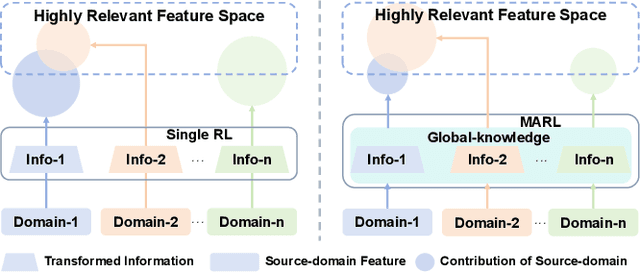

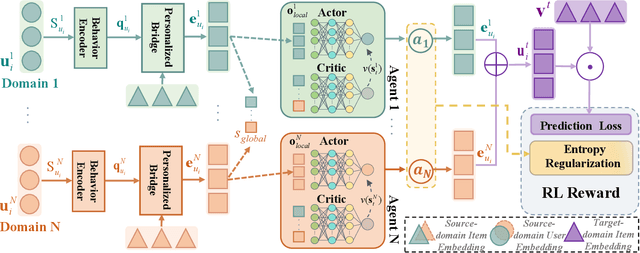
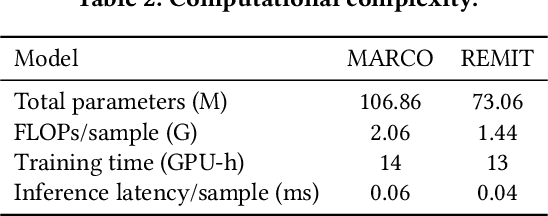
Abstract:Recommender systems frequently encounter data sparsity issues, particularly when addressing cold-start scenarios involving new users or items. Multi-source cross-domain recommendation (CDR) addresses these challenges by transferring valuable knowledge from multiple source domains to enhance recommendations in a target domain. However, existing reinforcement learning (RL)-based CDR methods typically rely on a single-agent framework, leading to negative transfer issues caused by inconsistent domain contributions and inherent distributional discrepancies among source domains. To overcome these limitations, MARCO, a Multi-Agent Reinforcement Learning-based Cross-Domain recommendation framework, is proposed. It leverages cooperative multi-agent reinforcement learning, where each agent is dedicated to estimating the contribution from an individual source domain, effectively managing credit assignment and mitigating negative transfer. In addition, an entropy-based action diversity penalty is introduced to enhance policy expressiveness and stabilize training by encouraging diverse agents' joint actions. Extensive experiments across four benchmark datasets demonstrate MARCO's superior performance over state-of-the-art methods, highlighting its robustness and strong generalization capabilities. The code is at https://github.com/xiewilliams/MARCO.
SAMPO:Scale-wise Autoregression with Motion PrOmpt for generative world models
Sep 19, 2025Abstract:World models allow agents to simulate the consequences of actions in imagined environments for planning, control, and long-horizon decision-making. However, existing autoregressive world models struggle with visually coherent predictions due to disrupted spatial structure, inefficient decoding, and inadequate motion modeling. In response, we propose \textbf{S}cale-wise \textbf{A}utoregression with \textbf{M}otion \textbf{P}r\textbf{O}mpt (\textbf{SAMPO}), a hybrid framework that combines visual autoregressive modeling for intra-frame generation with causal modeling for next-frame generation. Specifically, SAMPO integrates temporal causal decoding with bidirectional spatial attention, which preserves spatial locality and supports parallel decoding within each scale. This design significantly enhances both temporal consistency and rollout efficiency. To further improve dynamic scene understanding, we devise an asymmetric multi-scale tokenizer that preserves spatial details in observed frames and extracts compact dynamic representations for future frames, optimizing both memory usage and model performance. Additionally, we introduce a trajectory-aware motion prompt module that injects spatiotemporal cues about object and robot trajectories, focusing attention on dynamic regions and improving temporal consistency and physical realism. Extensive experiments show that SAMPO achieves competitive performance in action-conditioned video prediction and model-based control, improving generation quality with 4.4$\times$ faster inference. We also evaluate SAMPO's zero-shot generalization and scaling behavior, demonstrating its ability to generalize to unseen tasks and benefit from larger model sizes.
GALA: Guided Attention with Language Alignment for Open Vocabulary Gaussian Splatting
Aug 21, 2025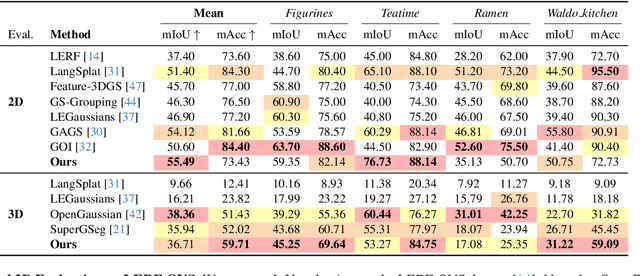
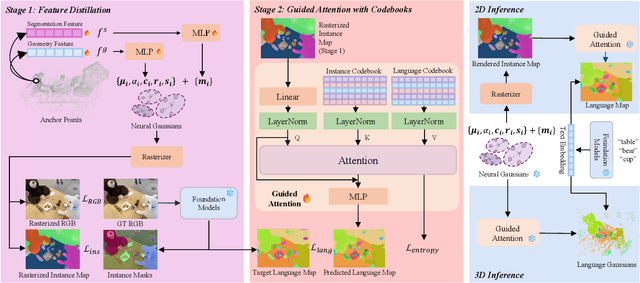

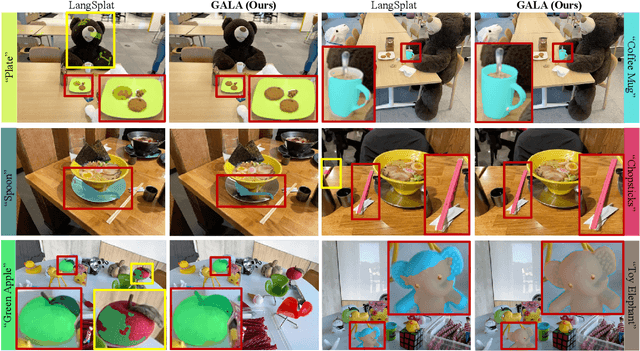
Abstract:3D scene reconstruction and understanding have gained increasing popularity, yet existing methods still struggle to capture fine-grained, language-aware 3D representations from 2D images. In this paper, we present GALA, a novel framework for open-vocabulary 3D scene understanding with 3D Gaussian Splatting (3DGS). GALA distills a scene-specific 3D instance feature field via self-supervised contrastive learning. To extend to generalized language feature fields, we introduce the core contribution of GALA, a cross-attention module with two learnable codebooks that encode view-independent semantic embeddings. This design not only ensures intra-instance feature similarity but also supports seamless 2D and 3D open-vocabulary queries. It reduces memory consumption by avoiding per-Gaussian high-dimensional feature learning. Extensive experiments on real-world datasets demonstrate GALA's remarkable open-vocabulary performance on both 2D and 3D.
Seedance 1.0: Exploring the Boundaries of Video Generation Models
Jun 10, 2025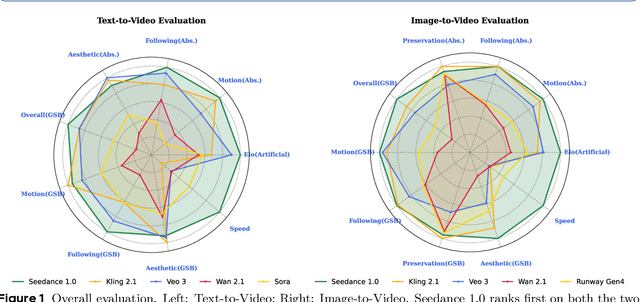
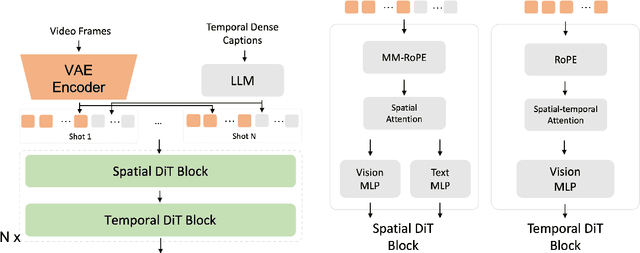

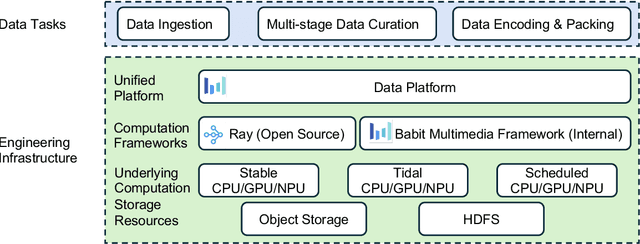
Abstract:Notable breakthroughs in diffusion modeling have propelled rapid improvements in video generation, yet current foundational model still face critical challenges in simultaneously balancing prompt following, motion plausibility, and visual quality. In this report, we introduce Seedance 1.0, a high-performance and inference-efficient video foundation generation model that integrates several core technical improvements: (i) multi-source data curation augmented with precision and meaningful video captioning, enabling comprehensive learning across diverse scenarios; (ii) an efficient architecture design with proposed training paradigm, which allows for natively supporting multi-shot generation and jointly learning of both text-to-video and image-to-video tasks. (iii) carefully-optimized post-training approaches leveraging fine-grained supervised fine-tuning, and video-specific RLHF with multi-dimensional reward mechanisms for comprehensive performance improvements; (iv) excellent model acceleration achieving ~10x inference speedup through multi-stage distillation strategies and system-level optimizations. Seedance 1.0 can generate a 5-second video at 1080p resolution only with 41.4 seconds (NVIDIA-L20). Compared to state-of-the-art video generation models, Seedance 1.0 stands out with high-quality and fast video generation having superior spatiotemporal fluidity with structural stability, precise instruction adherence in complex multi-subject contexts, native multi-shot narrative coherence with consistent subject representation.
RePaViT: Scalable Vision Transformer Acceleration via Structural Reparameterization on Feedforward Network Layers
May 28, 2025Abstract:We reveal that feedforward network (FFN) layers, rather than attention layers, are the primary contributors to Vision Transformer (ViT) inference latency, with their impact signifying as model size increases. This finding highlights a critical opportunity for optimizing the efficiency of large-scale ViTs by focusing on FFN layers. In this work, we propose a novel channel idle mechanism that facilitates post-training structural reparameterization for efficient FFN layers during testing. Specifically, a set of feature channels remains idle and bypasses the nonlinear activation function in each FFN layer, thereby forming a linear pathway that enables structural reparameterization during inference. This mechanism results in a family of ReParameterizable Vision Transformers (RePaViTs), which achieve remarkable latency reductions with acceptable sacrifices (sometimes gains) in accuracy across various ViTs. The benefits of our method scale consistently with model sizes, demonstrating greater speed improvements and progressively narrowing accuracy gaps or even higher accuracies on larger models. In particular, RePa-ViT-Large and RePa-ViT-Huge enjoy 66.8% and 68.7% speed-ups with +1.7% and +1.1% higher top-1 accuracies under the same training strategy, respectively. RePaViT is the first to employ structural reparameterization on FFN layers to expedite ViTs to our best knowledge, and we believe that it represents an auspicious direction for efficient ViTs. Source code is available at https://github.com/Ackesnal/RePaViT.
DARLR: Dual-Agent Offline Reinforcement Learning for Recommender Systems with Dynamic Reward
May 12, 2025
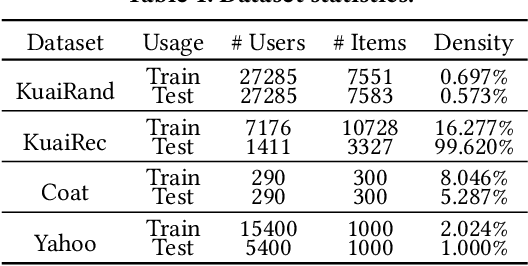
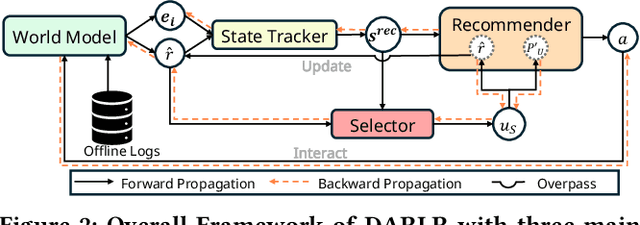

Abstract:Model-based offline reinforcement learning (RL) has emerged as a promising approach for recommender systems, enabling effective policy learning by interacting with frozen world models. However, the reward functions in these world models, trained on sparse offline logs, often suffer from inaccuracies. Specifically, existing methods face two major limitations in addressing this challenge: (1) deterministic use of reward functions as static look-up tables, which propagates inaccuracies during policy learning, and (2) static uncertainty designs that fail to effectively capture decision risks and mitigate the impact of these inaccuracies. In this work, a dual-agent framework, DARLR, is proposed to dynamically update world models to enhance recommendation policies. To achieve this, a \textbf{\textit{selector}} is introduced to identify reference users by balancing similarity and diversity so that the \textbf{\textit{recommender}} can aggregate information from these users and iteratively refine reward estimations for dynamic reward shaping. Further, the statistical features of the selected users guide the dynamic adaptation of an uncertainty penalty to better align with evolving recommendation requirements. Extensive experiments on four benchmark datasets demonstrate the superior performance of DARLR, validating its effectiveness. The code is available at https://github.com/ArronDZhang/DARLR.
Seaweed-7B: Cost-Effective Training of Video Generation Foundation Model
Apr 11, 2025Abstract:This technical report presents a cost-efficient strategy for training a video generation foundation model. We present a mid-sized research model with approximately 7 billion parameters (7B) called Seaweed-7B trained from scratch using 665,000 H100 GPU hours. Despite being trained with moderate computational resources, Seaweed-7B demonstrates highly competitive performance compared to contemporary video generation models of much larger size. Design choices are especially crucial in a resource-constrained setting. This technical report highlights the key design decisions that enhance the performance of the medium-sized diffusion model. Empirically, we make two observations: (1) Seaweed-7B achieves performance comparable to, or even surpasses, larger models trained on substantially greater GPU resources, and (2) our model, which exhibits strong generalization ability, can be effectively adapted across a wide range of downstream applications either by lightweight fine-tuning or continue training. See the project page at https://seaweed.video/
Digital Beamforming Enhanced Radar Odometry
Mar 17, 2025Abstract:Radar has become an essential sensor for autonomous navigation, especially in challenging environments where camera and LiDAR sensors fail. 4D single-chip millimeter-wave radar systems, in particular, have drawn increasing attention thanks to their ability to provide spatial and Doppler information with low hardware cost and power consumption. However, most single-chip radar systems using traditional signal processing, such as Fast Fourier Transform, suffer from limited spatial resolution in radar detection, significantly limiting the performance of radar-based odometry and Simultaneous Localization and Mapping (SLAM) systems. In this paper, we develop a novel radar signal processing pipeline that integrates spatial domain beamforming techniques, and extend it to 3D Direction of Arrival estimation. Experiments using public datasets are conducted to evaluate and compare the performance of our proposed signal processing pipeline against traditional methodologies. These tests specifically focus on assessing structural precision across diverse scenes and measuring odometry accuracy in different radar odometry systems. This research demonstrates the feasibility of achieving more accurate radar odometry by simply replacing the standard FFT-based processing with the proposed pipeline. The codes are available at GitHub*.
AQUA-SLAM: Tightly-Coupled Underwater Acoustic-Visual-Inertial SLAM with Sensor Calibration
Mar 14, 2025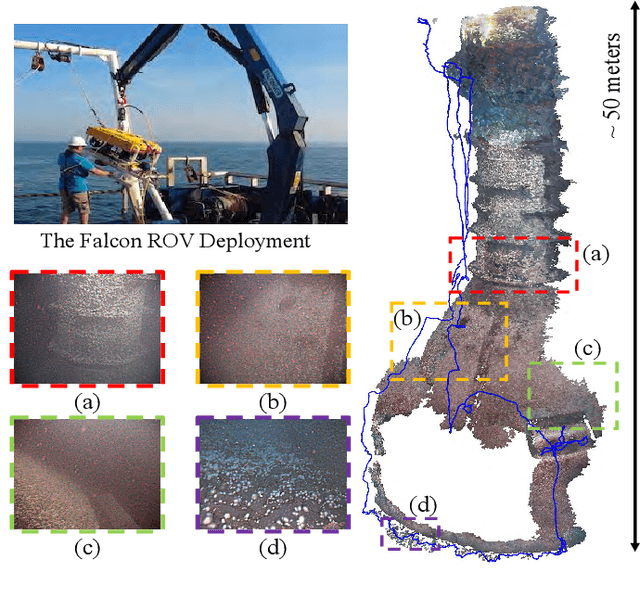


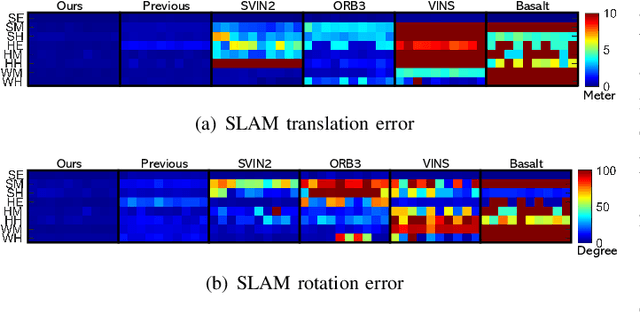
Abstract:Underwater environments pose significant challenges for visual Simultaneous Localization and Mapping (SLAM) systems due to limited visibility, inadequate illumination, and sporadic loss of structural features in images. Addressing these challenges, this paper introduces a novel, tightly-coupled Acoustic-Visual-Inertial SLAM approach, termed AQUA-SLAM, to fuse a Doppler Velocity Log (DVL), a stereo camera, and an Inertial Measurement Unit (IMU) within a graph optimization framework. Moreover, we propose an efficient sensor calibration technique, encompassing multi-sensor extrinsic calibration (among the DVL, camera and IMU) and DVL transducer misalignment calibration, with a fast linear approximation procedure for real-time online execution. The proposed methods are extensively evaluated in a tank environment with ground truth, and validated for offshore applications in the North Sea. The results demonstrate that our method surpasses current state-of-the-art underwater and visual-inertial SLAM systems in terms of localization accuracy and robustness. The proposed system will be made open-source for the community.
PanoGen++: Domain-Adapted Text-Guided Panoramic Environment Generation for Vision-and-Language Navigation
Mar 13, 2025Abstract:Vision-and-language navigation (VLN) tasks require agents to navigate three-dimensional environments guided by natural language instructions, offering substantial potential for diverse applications. However, the scarcity of training data impedes progress in this field. This paper introduces PanoGen++, a novel framework that addresses this limitation by generating varied and pertinent panoramic environments for VLN tasks. PanoGen++ incorporates pre-trained diffusion models with domain-specific fine-tuning, employing parameter-efficient techniques such as low-rank adaptation to minimize computational costs. We investigate two settings for environment generation: masked image inpainting and recursive image outpainting. The former maximizes novel environment creation by inpainting masked regions based on textual descriptions, while the latter facilitates agents' learning of spatial relationships within panoramas. Empirical evaluations on room-to-room (R2R), room-for-room (R4R), and cooperative vision-and-dialog navigation (CVDN) datasets reveal significant performance enhancements: a 2.44% increase in success rate on the R2R test leaderboard, a 0.63% improvement on the R4R validation unseen set, and a 0.75-meter enhancement in goal progress on the CVDN validation unseen set. PanoGen++ augments the diversity and relevance of training environments, resulting in improved generalization and efficacy in VLN tasks.
 Add to Chrome
Add to Chrome Add to Firefox
Add to Firefox Add to Edge
Add to Edge